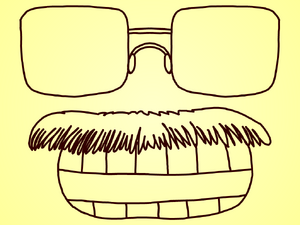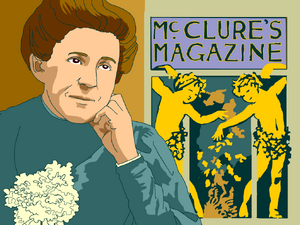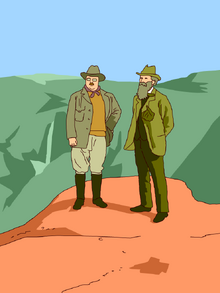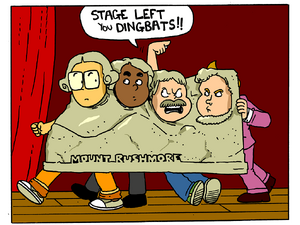| Theodore Roosevelt | |||
|---|---|---|---|
 | |||
| Airdate | January 27, 2010 | ||
| Curriculum | Social Studies | ||
Theodore Roosevelt is a BrainPOP Social Studies video that aired January 27, 2010.
Plot[]
Appearances[]
Errors[]
When Tim shows to Moby his Theodore Roosevelt costume, he is wearing his green gloves, but when Tim reads a letter about Theodore Roosevelt, he is holding the letter with one of his gloves off.
Transcript and Quiz[]
FYI[]
Trivia[]

Trivia
- Theodore Roosevelt’s second wife was his childhood friend and sweetheart, Edith Kermit Carow. They became reacquainted after Roosevelt’s first wife died, and they married in 1886.
- Theodore Roosevelt wrote 35 books, on topics ranging from naval history to hunting and ranching.
- Roosevelt gave his six children free reign of the White House. The young Roosevelts did crazy things like hiding a four-foot snake in an office to scare a group of Congressmen, spitballing an official portrait of Andrew Jackson, and sneaking a pony into one of the White House bedrooms.
- In 1906, Theodore Roosevelt became the first American to receive the Nobel Peace Prize. He won it for negotiating a treaty that ended a war between Russia and Japan.
- In 1912, Roosevelt was delivering a campaign speech in Milwaukee, Wisconsin, when he was shot in an assassination attempt. The bullet was slowed down by Roosevelt’s steel eyeglass case and a folded copy of his speech before it lodged in his chest. Roosevelt didn’t notice until someone told him he had a hole in his coat. He told the crowd that he had just been shot, and then delivered the 90-minute speech before going to the hospital.
- Theodore Roosevelt’s appearance was iconic — a major reason why he was featured in so many political cartoons. When he was President, the post office frequently delivered him letters addressed only with drawings of eyeglasses, mustaches, and big teeth!
- Theodore Roosevelt was a fifth cousin of President Franklin D. Roosevelt. FDR’s wife, Eleanor, was Theodore’s niece!
Personalities[]

During the Progressive Era, a group of journalists exposed the ugly side of American life—political corruption, poverty, unsafe working conditions, and unfair business practices. Theodore Roosevelt nicknamed these writers muckrakers. Here’s a look at some of them.
- Jacob Riis is best known for his photographs of the poorest residents of New York City. In 1890, he published a book called, How the Other Half Lives, which showed men, women, and children crammed into squalid tenement apartments, and laboring in dirty, unsafe conditions. For the first time, wealthy residents of New York saw what life was like in the slums, which led directly to a new era of reform.
- As a teenager, Ida Tarbell (pictured) watched as her father, a Pennsylvania oilman, was squeezed into bankruptcy by the Standard Oil trust. As an adult, she wrote a series of articles for McClure’s magazine exposing the trust’s unwholesome business practices. Published as a book in 1904, Tarbell’s work turned public sentiment against Standard Oil, and led the government to break up its monopoly in 1911.
- Lincoln Steffens worked alongside Ida Tarbell at McClure’s. His articles — collected in a 1904 book called The Shame of the Cities — exposed massive corruption in city governments throughout the United States.
- In 1906, a young writer named Upton Sinclair published a novel called The Jungle, which exposed the unhealthy conditions of Chicago’s meatpacking district. President Roosevelt sent two advisors to investigate Sinclair’s claims — and discovered that conditions were actually worse than Sinclair had described! The Jungle wound up playing a major role in the passage of the Pure Food and Drug Act of 1906.
Quirky Stuff[]

In mid-November, 1902, President Roosevelt went on a bear-hunting trip in Mississippi. He and his hunting party scoured the woods for several days, but couldn’t find a single bear.
Finally, Roosevelt’s guides came upon an elderly bear. They tracked it for hours, until it was exhausted, and then clubbed it and tied it to a tree. The guides then called Roosevelt in to shoot it — after all, they didn’t want the President of the United States to leave his bear hunt without killing a single bear!
But Roosevelt felt that shooting the dazed, injured bear for sport would be wrong. Instead, he asked his guides to put the wounded animal out of its misery.
The President’s bear hunt was a popular topic in the national press, and Clifford Berryman, a political cartoonist from the Washington Post, quickly published a drawing of the incident with the caption “Drawing the Line in Mississippi.” (Since Roosevelt had just settled a border dispute between Mississippi and Louisiana, the caption had a clever double meaning.)
The image caught on, and it was soon reprinted in other newspapers. Interestingly, the first version of the cartoon featured a large, adult bear — but soon, Berryman re-drew the image to show Roosevelt sparing a cuddly little cub.
Inspired by the cartoon, two Brooklyn shopkeepers — Rose and Morris Michtom — displayed a stuffed bear in their window, and labeled it “Teddy’s Bear.” Customers began asking to buy it, and after Roosevelt gave the couple permission to use his name, the Michtoms began producing “Teddy bears” full-time. The bear was adopted as the symbol of Roosevelt’s 1904 re-election campaign, and ever since, it’s been an American icon!
In Depth[]

As Tim mentions in the movie, Theodore Roosevelt was an avid conservationist and environmentalist. In fact, when he was a boy, he began his own Museum of Natural History inside his house!
During his Presidency, Roosevelt established five national parks, 18 national monuments, 51 bird sanctuaries, and four national game refuges. All in all, he placed 930,000 square kilometers of American land under federal protection.
Most importantly, he passed the Antiquities Act of 1906, which allowed future Presidents to decree that certain “historic landmarks, historic or prehistoric structures, and other objects of historic or scientific interest” would be off-limits to development.
Roosevelt also befriended the era’s two most prominent environmentalists: Gifford Pinchot and John Muir. Pinchot served as the first director of the National Forest Service. And in 1903, Roosevelt and Muir (pictured) took an extended hiking trip in Yosemite National Park — an act which heightened Roosevelt’s commitment to conservation.
But while Roosevelt may have placed a high value on the environment, he was also an avid hunter. In fact, Roosevelt made his first-ever trip to the Dakota Territory with the express purpose of shooting an American buffalo (he did so, and hung its head on the wall of his house in New York).
Interestingly, the “Teddy bear” (see Quirky Stuff FYI) may never have been invented if Roosevelt hadn’t been on a quest to kill a bear in Mississippi. And in 1909, he traveled to Africa to hunt specimens for the American Museum of Natural History and the Smithsonian Institution. He and his companions trapped or killed more than 11,000 specimens!
Quotables[]

Here are some quotations from Theodore Roosevelt!
“In life, as in a football game, the principle to follow is: Hit the line hard; don't foul and don't shirk, but hit the line hard!”
“In any moment of decision the best thing you can do is the right thing, the next best thing is the wrong thing, and the worst thing you can do is nothing.”
“Far and away the best prize that life has to offer is the chance to work hard at work worth doing.”
“We are not hostile to [large corporations]; we are merely determined that they shall be so handled as to [serve] the public good. We draw the line against misconduct, not against wealth.”
“We demand that big business give the people a square deal; in return we must insist that when anyone engaged in big business honestly endeavors to do right he shall himself be given a square deal.”
“A good many of you are probably acquainted with the old proverb, ‘Speak softly and carry a big stick — you will go far.’ If a man continually blusters, if he lacks civility, a big stick will not save him from trouble, and neither will speaking softly avail, if [behind] the softness there does not lie strength [and] power.”
“I abhor unjust war. I abhor injustice and bullying by the strong at the expense of the weak, whether among nations or individuals… I advocate preparation for war in order to avert war; and I should never advocate war unless it were the only alternative to dishonor.”
FYI Comic[]

